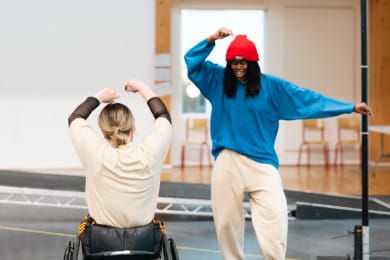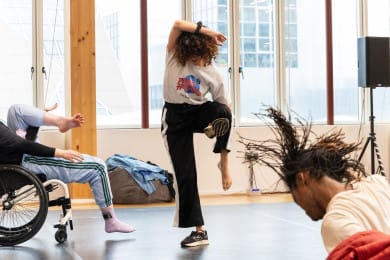Postcards from the Studio – Week 10

Apologies I didn’t manage a postcard last week – my capacity was maxed out and I gave myself the grace of rest, as I’ve been encouraging my colleagues to do. It may come as no surprise that it’s been easier to structure rest and create a rest friendly studio than it is to create rest friendly structures for an organisation – that is another piece of work we need to think about if we are to move towards more crip friendly ways of working across all the work we do, office based or studio based. But that’s a topic for another moment – we are less than a week away from our preview at Attenborough Centre for the Creative Arts, Brighton!
In my last ‘Postcard from the Studio’ I focussed on Anna Seymour and Maiya Leeke’s practice. So before we transition to production week and touring, I wanted to take time to share the dance practices of the other members of Candoco Dance Company which were explored in the studio.
Temitope Ajose’s practice works with improvisation and sounding to unlock movement vocabulary. Her class took us through a score to find different connections, unusual connections, as body parts pass one another, move closer to or away from one another. The exercise felt like it helped me to map my body in ways I’ve not done before. In her class we also travelled across the room in pairs, sounding and moving in response to our partner. I am always struck by how sounding – whether that is quietly or loudly, ‘good sounds’ or ‘bad sounds’ can shift our movement vocabulary. It’s as if by asking ourselves to do two things at once, we unlock something less codified and more unusual, allowing for dance and movement we might ordinarily judge and never share.
In Temi’s own words:
“Playfulness is important to me and the voice expressed beyond the sophistication of language draws the body into new territories. I like to also think of the voice calling out to ancestors and humankind across the ages so it connects the primal self and the modern human in long forgotten ways”
“In the show I draw from my long archive of dance, I experience a multiplicity in the body that is deliciously explored. I have many ‘ghosts’ within that I allow to emerge and help me arrive and pass through idiosyncratic languages necessary in the show.”
Annie Edward’s class began with rest and invited us to move gently between positions of true rest for us. Gradually the time between transitions shortens, and you find yourself moving between restful positions fluidly, gently, with a real efficiency of movement. This way of almost tricking my body into dancing, through resting, was so welcome to me and welcomed by the group. Annie’s class also taught us a basic rhythm from house dance, which we then improvised with and riffed on, until we were all joyously travelling through space with the rhythm and syncopation of house music. Finding ways to be in unison but still true to our own bodies and the way we move is really interesting. And rhythm is a good way to find that unison and togetherness. This is something we do in certain sections of the show.
In Annie’s own words:
“I developed this class from my own movement practice that aims to centre the contradictions of choosing to dance when experiencing chronic pain. It uses movements like rocking, self touch and pausing to ease dance into the body and try to keep the physicality we explore in line with our limits of pleasure, so as to not go further from, but deeper into what our bodies can do.”
James Olivo’s class began from stillness and breath and noticing. He then guided us through a series of ‘noticing’s’, gently voicing possible things to notice and respond to, slowly opening our bodies and our awareness. His class is held with softness, which is a cornerstone of James’s practice, and something he practices as a way of being in the world. This softening allows him to create length and breadth, because he never accepts an edge to his movement or his body, he is always thinking about where he can soften to continue the reach. Jame’s class also includes exercises of witnessing one another: in one score a duo would improvise, with one offering a series of movements their partner responds to, like a game of top trumps in movement, with a third person witnessing.
In Jamie’s own words:
“Witnessing is important for me and my practice, because it’s interconnected with being present in the moment, to really see ourselves and others, to feel seen and understood, which goes far beyond just in dance. To witness without judgment, to accept someone as they are, and their inherent beauty, for existing is enough.”
“In the show, I use my practice of softness to help me give space, consideration and understanding with others and myself. To soften any anxieties or stress, to be able to let go of criticising myself negatively, and approach myself with grace, instead of hardness, doubt and overthinking.”
The next postcard will be from ACCA during production week.
We’re nearly ready for an audience and hope that you can join us there.
Raquel
With the support of Dance Reflections by Van Cleef & Arpels.
This commission was also supported by Arts Council England, and Cockayne Grants for the Arts, held at The London Community Foundation.
Please head to our Over and Over (and over again) page for more information about this work, the confirm dates and for the full list of credits. Scroll down for updates about the previous weeks of rehearsals.










